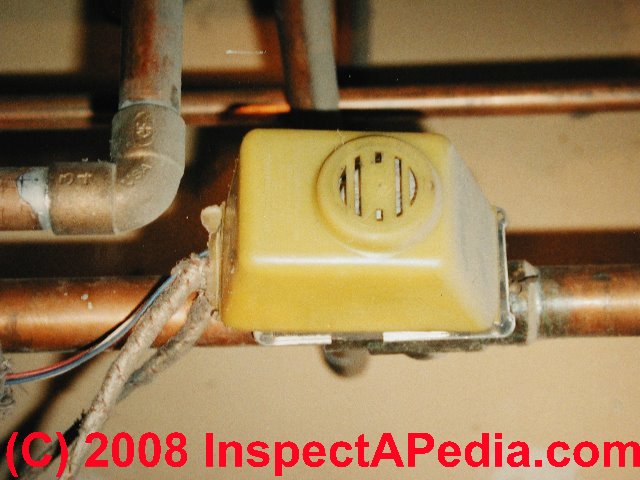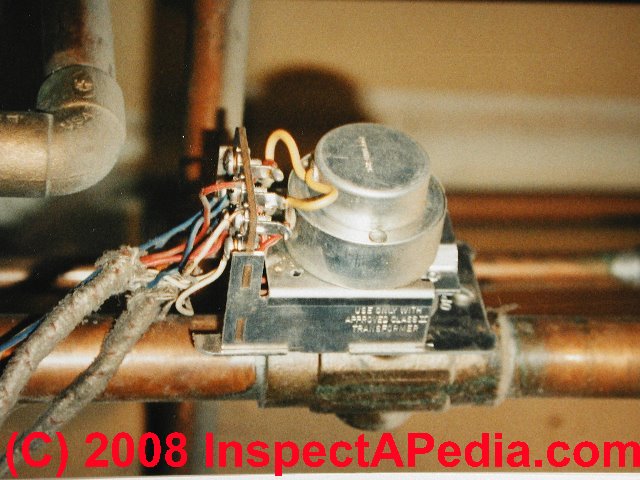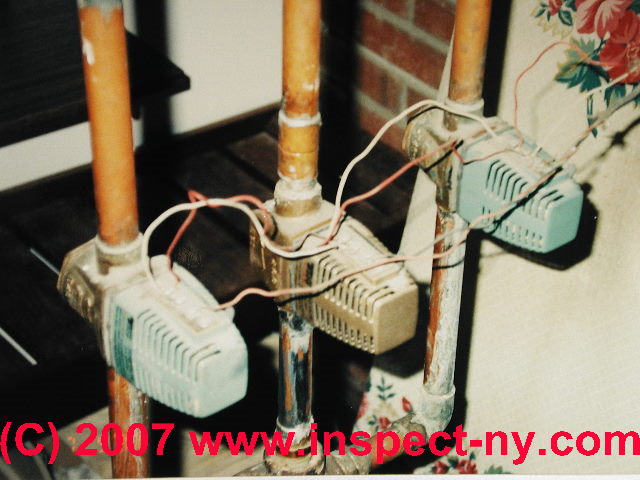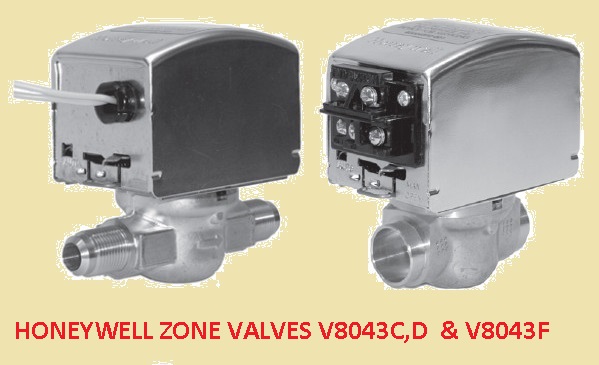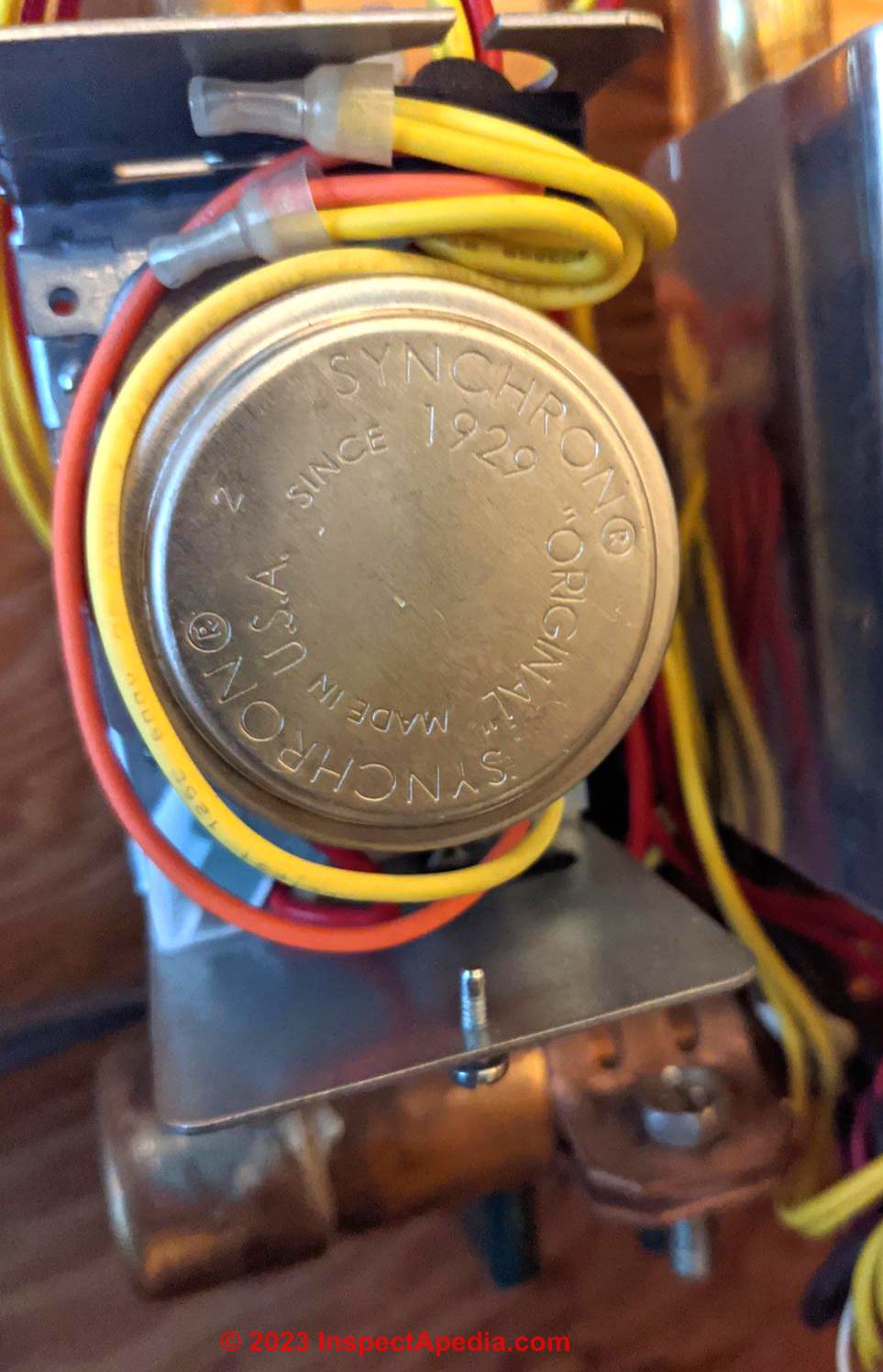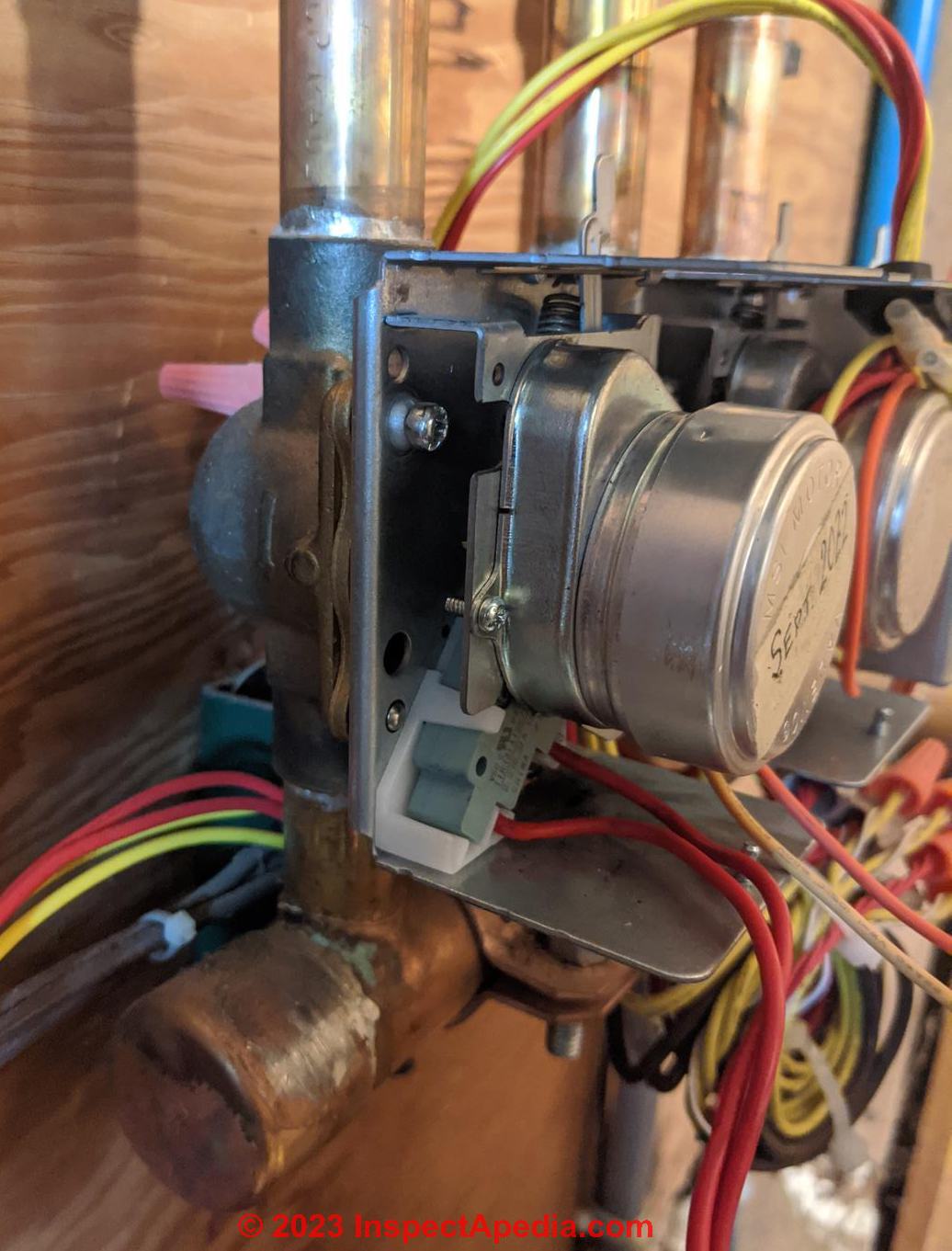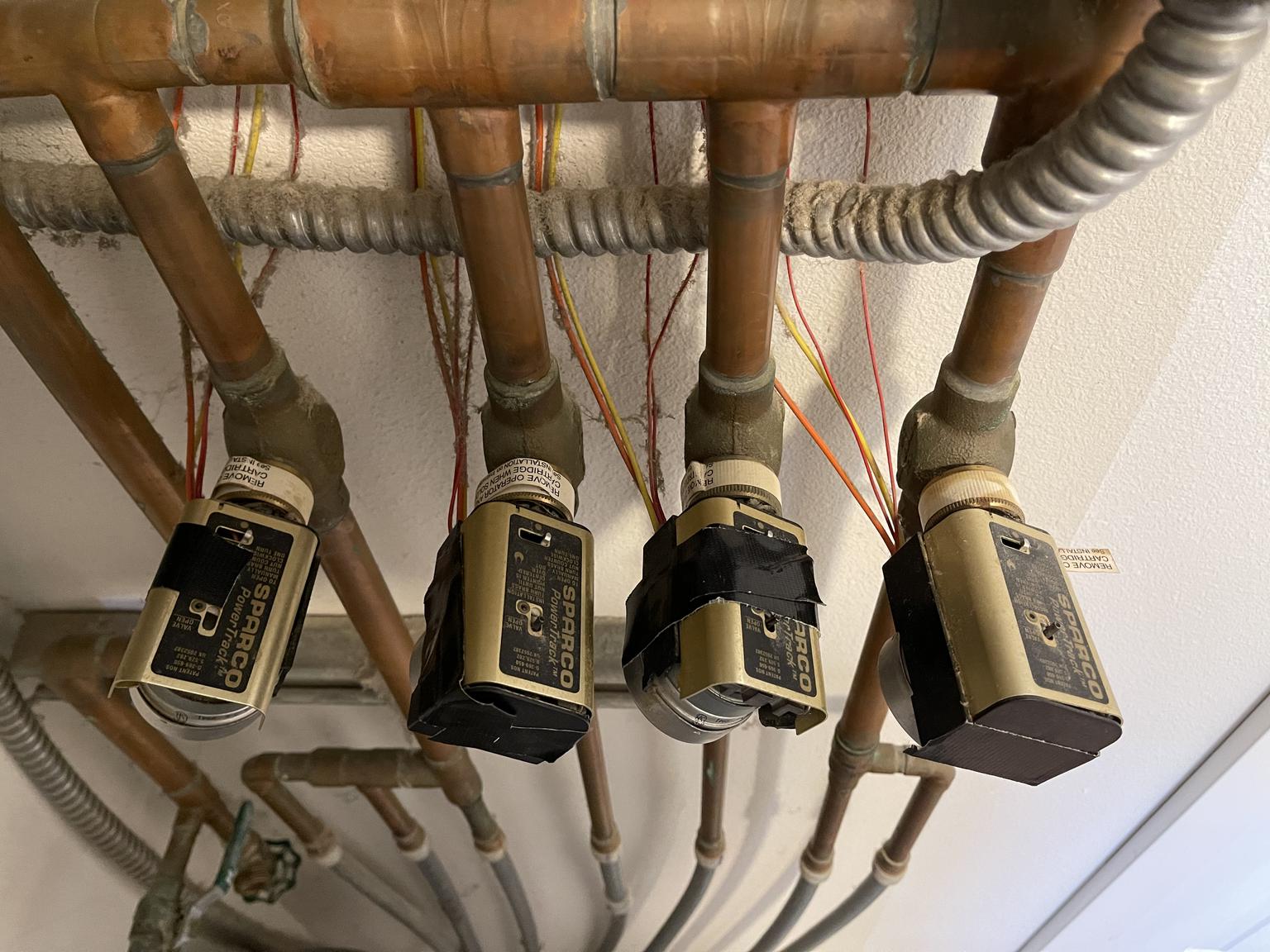 Heating Boiler Zone Valves
Heating Boiler Zone Valves
Install,wire, troubleshoot or repair a zone valve
- POST a QUESTION or COMMENT about zone valves on hot water heating systems: installation, diagnosis, repair advice
Zone valves on hot water heating systems:
What is a zone valve, how do they work.
How do I choose & install a zone valve, how do I wire up a zone valve, and how do I troubleshoot, repair or replace a zone valve?
This article series answers most questions about Heating System Boiler Controls on central heating systems to aid in troubleshooting, inspection, diagnosis, and repairs.
The photo above shows a bank of six zone valves controlling heat distribution in a large home.
InspectAPedia tolerates no conflicts of interest. We have no relationship with advertisers, products, or services discussed at this website.
- Daniel Friedman, Publisher/Editor/Author - See WHO ARE WE?
Explanation of Zone Valves on Heating Boilers - Controlling Hot Water Heat
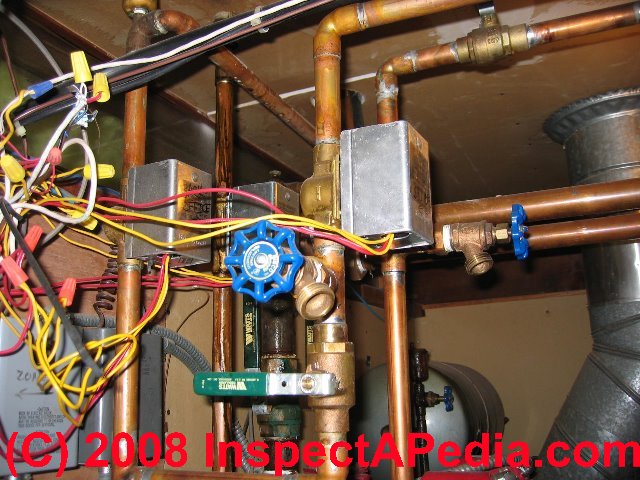 Our photo shows a Honeywell (TM) zone valve installation (silver box with yellow and red wires, at center and left of our photo).
Our photo shows a Honeywell (TM) zone valve installation (silver box with yellow and red wires, at center and left of our photo).
Heating water piping in a building, particularly where hot water baseboard heat is used, may be divided into separate heating zones (different floors, or different areas on a single floor) to permit more detailed control of heat distribution in a building.
The control of heating water through these different heating zones may be accomplished by use of zone valves (one per heating zone or area or "loop" of heating piping) which in turn are connected to individual thermostats.
When the thermostat calls for heat in a particular building area, the thermostat switch causes the zone valve to open, to permit hot water to flow through that zone.
Other brands of zone valves such as those made by Flair (TM) (problem prone - shown below), and White Rodgers work similarly but their wiring may be slightly different. Wiring details for the yellow Flair Zone-A-Trol valve shown above are given
at ZONE VALVE MANUALS & WIRING INDEX
Below: an obsolete but still-working Flair zone valve with its yellow plastic cover.
In all cases, when the zone valve is fully open, an "end switch" inside the valve tells the heating system's circulator to begin operating, causing hot water to flow through the zone.
Below: the same Flair zone valve with its plastic cover removed to show the motor, actuator, and wiring.
Typically heating systems using zone valves will have two or more zone valves (usually but not always located close to the heating boiler) and a single circulator pump (usually located on the return end of the hot water piping close to the heating boiler).
But if you see a zone valve with the cover off (photo at left) that may be a clue that the valve has been having problems with jamming or sticking - someone left the cover off to try to keep the valve a little cooler.
Good installation details install a zone valve on the return side of the heating piping loop where it will be exposed to lower and thus less stressful temperatures.
Zone Valve Defects Checklist
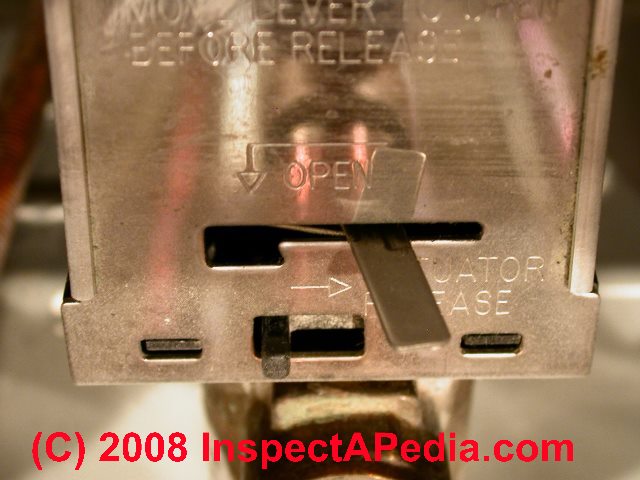
- Zone valve does not work:
jammed, stuck, does not open in response to call for heat at that zone.
Provided the wiring and thermostat are correct and operating, if no hot water flows past the valve on a call for heat (feel the pipes for heat) it may be jammed and need replacement
Our photo shows the manual control valve in its "automatic" or normal position on a Honeywell™ heating zone control valve.
See ZONE VALVE LIFE Affected by Boiler Water Chemistry below - Zone valves installed on the hot side or boiler:
out side of the heating piping loop, exposing the valve to higher and more stressful temperatures - Zone valve installed backwards:
the valve must be installed so that the arrow on the valve body matches the direction of flow of the hot water.
See ZONE VALVE BANGING or BACKWARDS
Water hammer, discussed in general
at WATER HAMMER NOISE DIAGNOSE & CURE - Zone valve with covers off:
may indicate overheating and jamming - Zone valve with its manual lever left in the manual "on" position:
may indicate that the valve does not work - this zone is forced into "always on" status.
In our photo above, that notch at the left end of the zone valve control lever will "lock" the valve in the open position.
In normal, not-locked-open operation, the lever will move from left to right in the horizontal slot as the zone valve motor opens (lever to left) or closes (lever to right) the valve.
Below: Flair zone valves.
- Stuck Zone Valves: Older models of some zone valves:
such as these Flair™ valves are perhaps more likely to be "stuck" either open (you'll have heat in that zone) or shut (that zone won't heat). - Uneven zone heat distribution:
among multiple zone-valve controlled heating zones:
Because heating zone piping and zone size or zone area heat loss may vary widely within an individual building, if we cannot regulate the hot water flow in individual zones we may find that when more than one of the thermostats are calling for heat at once, some building areas may be too cold while others may be too warm.
The heating system installer or service technician addresses this heat imbalance by fine-tuning the volume or the rate at which heating water is delivered to different building areas.
She or he does this by installing and adjusting manual or automatic zone balancing valves or zone flow control valves of various types.
See CHECK VALVES, HEATING SYSTEM for details.
- Zone valve is leaking:
leaky zone valves will stop working soon and need replacement. Example:
Norby said: (2/1/2014)I have a zone valve dripping and when the thermostat turns on the zone valve spins and won't stop on open. It will close when the thermostat shuts off. If I disconnect the wiring and leave the zone valve open will it only pump water thru that zone when another zone is open and making the pump run?
Reply: Norby,
When a zone valve is dripping from the solder or sweat connections it may be possible to repair it - but that'll usually require draining water out of the zone piping first. If the valve is dripping from the valve assembly or motor it's shot and needs replacement.
If the valve spins but doesn't open I suspect the motor shaft is broken - in which case it might be possible to open the valve using the manual latch if your model has one.
In that case if the circulator runs hot water will circulate. You can know that the valve is open if hot water is felt in the pipe on the output side of the zone valve. - Zone valves overloading their power transformer:
powering too many zone valves from a single low voltage transformer can damage both the zone valves themselves as well as the transformer.
Reader Comment: details of excessive VA load on a transformer
Andre said:
Just curious about the query whose 7 zone valves keep failing once a year. I wonder what the rating on the transformer is? If it's a standard 40VA like you find on a lot of equipment from the factory, 7 of those valves will try to draw 60VA if they all open at once.
The voltage will sag, the current will go through the roof, and you'll burn the windings on those tiny synchronous motors. And this is not just an instantaneous short either - once those valves start going, they keep going as long as necessary. Reader should make sure they have at least a 75VA transformer for the valves - 60VA for full load plus 20% headroom.
Reply:
Good question, Andre.
We often read about people hooking up too many zone valves to a single transformer, overloading it. When updating this article I'll be sure to include your helpful comment.
Readers should also see inspectapedia.com/heat/Low-Voltage-Transformer-Test.php
LOW VOLTAGE TRANSFORMER TEST
and
also see ZONE VALVE MANUALS & WIRING INDEX
Banging Heating Zone Valve: Backwards Zone Valves
Cures for Heating Boiler Water Hammer Noise at Zone Valves
Water hammer, discussed in general
at WATER HAMMER NOISE DIAGNOSE & CURE, can occur in both building potable water supply systems (sinks, tubs, showers) and also in hot water heating systems as well as at water heaters or calorifiers.
At any water heating equipment, such as a heating boiler or a water heater, water hammer risks an additional hazard besides noise: water hammer can cause leaks at the temperature/pressure relief valve.
And over time a relief valve that leaks can also clog from mineral deposits and - to put it technically - crud on the valve seat. A clogged relief valve means that the heating equipment is unsafe to operate, risking a BLEVE.
See BLEVE EXPLOSIONS for details.
If your heating system is giving a loud BANG when the zone valves open or close (and circulator starts or stops) take a look at the location of the zone valves.
Good practice locates the zone controls and circulators on the return side of the hydronic heating loop. There's theory that the slightly lower temperatures give longer component life and that this location will reduce water hammer noise in the heating zones.
By locating the circulator downstream from the return-side zone valves - that is, between the zone controls and the boiler, the impact of the pump start-up on the zone valve is reduced.
If you continue to have annoying water hammer banging when the circulator pump starts (or stops) consider changing out your zone valves to a slow closing valve such as the Taco #570.
Question: what's wrong with installing a zone valve backwards
6 Nov 2015 merlejan said:
What is the downside to installing a 4043 zone valve backwards?
Reply: problems caused by zone valves installed backwards include banging pipes and reduced valve life
Merle
A slow-closing type zone valve may cause banging heating pipes if installed backwards. Here are some details:
Honeywell, for example, says the zone valve "... must be installed so that the arrow stamped on the body corresponds to the flow direction".
- Honeywell V8043D ZONE VALVE INSTALLATION GUIDE [PDF]
The instructions don't say why but from my reading and field experience I warn that if you hook up a heating zone valve backwards, depending on several other variables including zone valve brand and model and type as well as water velocity there may be trouble:
- The zone valve (installed backwards) may have trouble closing against the force of water being pushed or pulled by the circulator pump - a likely problem since in a zone valve system typically one circulator serves multiple zones (and zone valves)
- A flow restriction if you install the valve backwards
- Banging heating pipes and possible valve damage when the valve closes as a consequence of load on or wear of the mechanically-operated valve gate
- Banging heating pipes when the valve is closing or closed while another heating zone is calling for heat (more likely with fast-closing zone valves and with zone valves on zones operating at higher pressure or faster water circulating rates) (Some experts opine that a White Rodgers zone valve is more quiet-operating)
See WR zone valve manuals at WHITE RODGERS CONTROLS & MANUALS - all
I would not recommend modifying a bangs-at-closing zone valve by removing or weakening its closing springs as doing so is ultimately likely to lead to premature valve failure-to-close. I figure that the manufacturer wouldn't have put parts (springs) in the valve if they were not needed. - If the actual valve is a "paddle valve" type closure the valve may not open and close properly and may flutter, bang, or jam.
Common Sources of Banging Pipes on Hot Water Heating Systems & Water Heaters
To be fair, not all banging noises originate at a backwards zone valve. Here are other sources of banging noises in buildings:
- APPLIANCE NOISE DIAGNOSIS
- BANGING HEATING PIPES RADIATORS
- BANGING WATER HEATER
- BANGING WATER PIPES
- WASHING MACHINE NOISE CAUSE & CURE
At WATER HAMMER NOISE DIAGNOSE & CURE we cite these other banging heating pipe sound sources
- Poorly-supported heating pipes - long loose floppy piping runs (leaks likely)
- Thermal expansion of pipes through tight building passages
See SOUND CONTROL for PLUMBING - High velocity hot water circulators combined with fast-closing zone valve models
See CIRCULATORS VARIABLE SPEED - Air in the hot water heating system
See AIR-BOUND HEATING SYSTEMS - home - Water hammer anywhere in a hot water heating system or in the building plumbing system (also a function of water velocity and valve closing speed.
See WATER HAMMER NOISE DIAGNOSE & CURE
5 Simple Zone Valve Diagnostic Steps
- Mechanically-stuck zone valve motors.
If your zone valve has a manual override lever you can test the valve to see if it will open and shut. (Our Honeywell zone valve photo above shows this mechanical lever. The Flair zone valves at left do not have this feature).
If the valve can be operated mechanically but does not operate in response to the thermostat we suspect that there is - A bad zone valve drive motor :
the valve is not mechanically stuck but the zone motor won't operate the valve. Time for a new zone valve. - Faulty zone valve wiring connections or thermostatic control.
Watch out: different brands of zone valves may require different wiring hook-ups and a mix of zone valve brands can lead to some head-scratching in figuring out proper wiring.
I can't give a general solution to this problem as we need to look at the wiring diagram. But yes, the problem can be solved. - No electrical power to the zone valve unit
or to the thermostat that controls it - Air-bound hydronic heating system:
if the zone valve appears to operate properly but heat never arrives in the zone it controls,
check that the system circulator pump
(CIRCULATOR PUMPS & RELAYS
is working (pump motor hums & moves, pipes get hot on both sides of the circulator inlet and outlet).
If the circulator pump is spinning and the zone valve is open,
see AIRBOUND HEAT SYSTEM REPAIR by WATER FEED VALVE.
While going through the detailed sequence in the operation of the heating boiler, watch for and inspect the condition of the heating boiler controls and safety devices (as required by ASHI 9.1.A.3 automatic safety controls).
Boiler Component & Heating Zone Valve Life Affected by Boiler Water Chemistry
Watch out: for boiler water chemical conditions that could contribute to zone valve failure. These include highly-corrosive water, improper pH, and water with a high oxygen content.
[The Honeywell Honeywell V8043 series zone valve is ] suitable for glycol/water mix up to 50:50 use in closed hydronic systems. Not for use with oxygenated water, potable water or steam.
Use this valve in hydronic systems which DO NOT contain dissolved oxygen in the system water. The dissolved oxygen, which is found in systems that have a frequent source of make-up water, causes the rubber plug inside the valve to deteriorate and eventually fail. - HONEYWELL V8043D ZONE VALVE INSTRUCTIONS [PDF]
Details on the risks of damage or component failure from dissolved oxygen in heating system water as well as suggestion on avoiding those hassles are now found
at DISSOLVED OXYGEN DAMAGE CONTROL.
Zone Valves on Indirect-Fired Domestic Hot Water Heaters
Sketch above: courtesy of Carson Dunlop Associates, a Toronto home inspection, education & report writing tool company [ carsondunlop.com ] showing an indirect-fired water heater (left) being heated by the home's heating boiler.
Indirect fired hot water heaters, in some designs, use a heating coil located in the bottom of the hot water tank to heat the domestic hot water (used for washing and bathing).
A typical design will include a thermostat on the water heater that will cause hot water from a physically separate heating boiler to circulate through the heating coil located in the bottom of the indirect-fired water heater.
A separate loop of piping conducts water from a nearby heating boiler, through the coil in the bottom of the indirect fired water heater tank (thus transferring heat to water in the water heater tank), and back to the heating boiler.
The water temperature inside the indirect fired water heater tank is sensed by a thermostatic control that causes the hot water tank's contents to be re-heated as needed, typically by turning on a circulator pump that moves hot water from the separate heating boiler through the coil in the bottom of the water heater.
While typical indirect water heaters use a heating loop encompassing a circulator pump and check valve, some systems may use a zone valve in this piping loop that first opens to let hot water flow though the piping loop (boiler to water heater coil and back to boiler), and second, when the valve has opened, it turns on a circulator pump to cause water movement.
This arrangement (or a simple check valve) prevents water in the hot water tank from being heated by the boiler when it is not needed (circulating by convection, for example).
See INDIRECT-FIRED WATER HEATERS for details.
Number of Heating Zones: How can I determine how many heating zones I have?
I took a look at the boiler. I see the 5 zones going off the outbound pipe, but I only see 2 converging back to the intake. Do you think that means the zones are not all individual loops? - Lisa
Reply:
Most likely you have
5 individual room thermostats
5 individual heating zones
5 loops of hot water heating piping leaving the boiler (one at each zone valve)
but at some convenient locations the installer joined several of those individual zones into one of two return lines - that's why you see just two hydronic heat (hot water) lines returning to the boiler.
You can still drain and turn off 3 of the zones but you'll need a plumber to find the END of each of the loops you want to turn off - right where it joins a common return line. There s/he will install a drain and control valve. It may be necessary to add air bleeder or air purge valves to permit draining of individual heating zones.
See AIR BLEED VALVE INSTALLATION
The risks of turning off heat completely, besides my previous warning about not getting all the water out, are that you freeze up plumbing somewhere. If the zones do NOT heat any rooms with plumbing you may be ok.
An alternative, and the one that I use, is to keep all 5 zones working, but set the thermostats for the three unused areas to a lower than usual temperature, just high enough to avoid freeze-ups - say 45 °F. You'll save significantly just by dropping the thermostat set temperature.
In an unfamiliar home I might try dropping the thermostat set temperature gradually in very cold weather, double-checking to see just how cold the room gets. You'll want the zones to run occasionally to protect against freezing.
Finally, for freeze protection advice for the building, see WINTERIZE A BUILDING ( a link I'll add at the ARTICLE INDEX the bottom of this article )
Heating Zone Valves: Normally-Closed vs Normally-Open Designs & Applications
Reader Question: do you advise swapping out Honeywell V8043D 5080 normally-open zone valves that keep failing?
Dennis B. Hoff said: (2/3/3014)
We have a hot water boiler with 7 normally open Honeywell zone valves. They are mounted on the hot side of the boiler. We have problems with the valve motors quitting (after about a year) and have to be replaced.
Would it be better to have normally closed valves instead of the normally open ones? They would only require power when heat is called for and may not heat up as much. Your advice would be appreciated. We live in a area with long cold winters.
Reply:
Dennis, I don't know. I'm not aware of temperature-tolerance differences among the two valve descriptions you cite, and am confused by the query: in my limited experience a heating zone valve is opened or closed by the room thermostat. On a call for heat the zone valve opens.
When the call for heat stops, the valve closes to stop circulating hot water.
However if you are going to the trouble of rearranging or re-sweating zone valves at a hot water heating boiler, I'd see if it were possible to put the valves on the return side of the boiler - cooler water temperatures there may improve zone valve life.
If you give us the zone valve brand and model we can research further. - Daniel
Follow-up:
Zone valves we are using are a Honeywell V8043D 5080 normally open (held open by spring pressure)
When room temperature is reached the thermostat applies power to the valve and it closes, cutting off fluid flow. In the normally closed valve the valve remains closed by spring pressure and opens when the thermostat apples power to it, allowing fluid flow.
When room temp. Is reached the thermostat cuts off power and the valve closes (by spring pressure) cutting off fluid flow.
There are also specific thermostats required for each type of valve.
The valves cannot be moved to return lines without a lot of work. I hope this helps. I do not have the part number for the normally closed valve handy. - Dennis
Reply:
Thanks Dennis, indeed you are perfectly correct: the HONEYWELL V8043D zone valve [PDF installation instructions] is a "normally open" valve while the Honeywell V8043C, F, or G models are "normally closed". Quoting from the company's product data:
The V8043 Motorized Zone Valve provides two-position (open-close) control of supply water for baseboard radiation, convectors, fan-coil units, etc. It uses a two-wire, 24-volt control circuit and requires a SPST thermostat.
Integral end-switch
models permit the sequencing of auxiliary equipment.
Quick Fit actuator provides easy snap on and off connection
to the valve assembly.
And I agree you'd need to look at thermostats and wiring if changing the zone valve type as a normally-open zone valve requires a reverse-acting thermostat (as you indicated).
It is possible to simply change the actuator heads from the D model to one of the other models - changing wiring and thermostats as appropriate, leaving the actual valve body installed.
A thermostat wired to operate a normally-open zone valve (NO valve) will need to be re-wired if it supports operating a normally-closed (NC) valve. Otherwise the thermostat will need replacement.
Before you would change to a "normally closed" zone valve (which is more common at least in residential installations) we'd want to understand how your heating system was designed to work. The installer surely had a reason for the "normally-open" approach.
Is this a residential building? Are there some special heating needs or applications?
I should add these details about the different Honeywell V8043 zone valves:
- The F and G models of this zone valve include an end-switch to permit switching auxiliary equipment such as a water circulating pump.
- Honeywell V8043D - normally OPEN (your valve) PN 4000396014 has NO END SWITCH - the installation presumes that the thermostat or other control is activating the circulator pump. This is the only one of the four models in this series that is a normally-open zone valve.
- Honeywell V8043D - normally CLOSED PN 4000396013 has an end-switch that will be used to activate a circulator or circulator relay.
- The Honeywell V8043F has these same features. It's safer to refer to the F model but I found it listed both ways. It pays to read the specs.
- Honeywell V8043C - PN 40003916011 normally closed, also has no end-switch.
Honeywell V8043G - PN 40003916012 normally closed has as an end-switch.,
You can obtain the installation guide and ask questions of Honeywell at 1 (877) 663 0316
And about using a normally-open vs normally-closed zone valve: it depends on the application; for example some hot water applications require the valve to be normally open.
Some writers opine that in some buildings we install a normally-open zone control so that " ... in the event of power failure or malfunction the suite won't freeze and bust up the plumbing and heating pipes."
- which is a bit unclear to me since in a power failure the heat is off and the circulator pump is off too - nothing is circulating. But you could argue that in the event of loss of heat but not loss of power, you'd gain that advantage. - Daniel
Follow-up:
What I understand is with the normally open valve power is required continuously keep the valve closed. I think that this could cause extra heat build up in the motor and cause premature failure along with more power usage. The normally closed valve only uses power to open the valve when heat is called for
.The application that we have is residential, but was originally installed when the house was built 29 years ago. It's a good system but we are trying to improve costs and new procedures develop with time. There are no special heating needs or requirements.
Thanks for all of the information it will help us in making a decision. Probably one thermostats at a time. - Dennis
Reply: dissolved oxygen in heating boiler water can cause zone valve failure
Dennis: thanks for the follow-up. keep us posted. As I noted, unless the valve mechanism itself is damaged, you can just change the power head - leaving the actual valve assembly in place. Quoting the product literature:
Easy servicing because the entire powerhead assembly can be replaced without removing valve body from line. Optional accessory fittings can be provided to facilitate convenient removal of the entire zone valve unit. - op cit.
When changing the thermostat, there are some models that can be wired to operate either type of zone valve: normally closed or normally open. An example we're looking at is the Honeywell FocusPro TH6110D programmable thermostat - it's quite versatile.
It's not clear to me that the added heat from the 40VA transformer wiring that powers this zone valve would normally be sufficient to contribute to the product's failure in the field. The temperatures of the circulating hot water are, in my OPINION more likely to be a factor in zone valve life.
Watch out: for conditions that could contribute to zone valve failure.
[The Honeywell Honeywell V8043 series zone valve is ] suitable for glycol/water mix up to 50:50 use in closed hydronic systems. Not for use with oxygenated water, potable water or steam. Use this valve in hydronic systems which DO NOT contain dissolved oxygen in the system water.
The dissolved oxygen, which is found in systems that have a frequent source of make-up water, causes the rubber plug inside the valve to deteriorate and eventually fail. - op cit.
Watch out: however, for wiring errors, short circuits, or a misbehaving low voltage transformer. Those defects could contribute to zone valve failure, as might corrosive or mineral-laden water in more rare cases.
See CHEMICAL TREATMENTS, BOILER
Heating Zone Valve Models & Installation Instructions
Moved to ZONE VALVE MANUALS & WIRING INDEX
...
Reader Comments, Questions & Answers About The Article Above
Below you will find questions and answers previously posted on this page at its page bottom reader comment box.
Reader Q&A - also see RECOMMENDED ARTICLES & FAQs
How to flush my hot water baseboard central heating system
I would like to flush my hot water baseboard CH system.
Can I lock the zone valves in the open position when I turn the power off to the boiler and circulating pump without damaging the zone valves or their actuators?
This would be for the duration of the flush, perhaps an hour or two. -On 2023-05-11 by Carr
Reply by InspectApedia Publisher - flush my hot water baseboard CH system
@Carr,
Yes, some zone valves like some of the Honeywell models we show in these articles have a lever that can be slid over and locked in a manual or open position without harming the valve at all.However you may need to move the lever with a tiny bit of patience as there's some force required to push it from closed to the locked open position. it just takes a moment.
Watch out: why are you flushing out the heating system? Normally that's not necessary.
Where to locate the zone valves
where would a valve for the basement in a four zone heating system be - On 2023-05-10 by annmarie
Reply by InspectApedia Editor - How to find the zone valve controlling a basement heating zone
@annmarie,
I think you're saying that heating for your whole building is divided into four zones, one of which serves the basement.
How to find the zone valve controlling a basement heating zone
The zone valve could, unfortunately, be anywhere on the loop of hydronic heating water that heats the basement, but usually the zone valve is close to the boiler, preferably on the piping that is returning to the boiler (as that's the cooler side of the heating loop).
So to find the basement heating zone valve let's
1. identify which pipes heat the basement - do this by turning the basement heat thermostat all the way UP. That should cause the zone valve for the basement to open (wherever that pesky valve is hiding) and then to turn on the circulator pump and hot water should start circulating from the boiler through the basement heating zone pipes. As boiler temperature drops the boiler's burner should come on, too.
It'll be better if for the time being all of the other heating thermostats are turned all the way DOWN so as to not call for heat.
2. Now feel the various heating zone pipes ( don't get burned!) leaving and returning to the boiler.
The hottest pipe will be the active heating zone - that should be the basement zone
3. Now follow that pipe out of and back into the boiler by eye as much as you can. You should see a zone valve on that pipe.
If you're not sure what a zone valve looks like, check out the photos above on this page and in other articles in this series.
Post a photo of what you find so that we can comment further.
Thank you for a helpful heating question.
On 2022-11-12 by Ben
Stupid question here, is a zone valve required on a single zone, in slab system?
Combi-boiler feeding indirect HWT and single zone in slab that has three loops of that helps for background information. The in-slab is not the primary source of heat for the area as well.
On 2022-11-12 by InspectApedia (Editor) - is a zone valve required on a single zone, in slab system
@Ben,
Typically the indirect hot water tank will be fed as a separate heating zone so you would need a zone valve that opens or closes between the boiler and that tank.
Therefore you ought to have a second zone valve to control the building heating loop.
That allows the two separate uses of the boiler to operate independently of one another.
Reduce zone valve closing speed to stop water hammer?
is there a way to reduce the speed at which the valve closes limiting water hammering? -On 2022-09-27 by jeremiah
Reply by InspectApedia (Editor) - "is there a way to reduce the speed at which the valve closes limiting water hammering?"
@jeremiah,
I have not seen any heating zone valve that offered a variable closing speed, though usually those valves don't close very fast anyway.
If you are having water hammer problems and you're sure it's from the zone valve, then you might try adding a water hammer arrester on the zone near the valve.
Details are at
WATER HAMMER NOISE DIAGNOSE & CURE
Diagnose & Fix a Heating Zone that is Stuck "ON"
I'm having persistent issues with my hydronic boiler system, specifically the downstairs zone is always stuck on, full blast. My system uses a single boiler with multiple Honeywell control valves. I've inspected the downstairs zone valve, and it's always open.
I've replaced the motor, and have removed/inspected the spring actuator that closes the valve, and it seems to be operating as it should.
When I detach the valve wires, it closes. When I re-attach them, the valve instantly opens, regardless of what the downstairs thermostat is set to.
The downstairs thermostat could be set to "off" and the control valve still opens up as soon as I reconnect the wires.
Initially I thought the valve motor or spring actuators were not working properly, but in light of what I'm seeing now, I'm wondering if my thermostat is the issue.
I believe the thermostat is a Honeywell TH4110U2005, however I don't see an exact model number or name on the unit.
My house doesn't have AC, so the thermostat only does heat.
Does anyone have any idea as to what my issue could be? The valve seems to work in every regard, but for some reason it thinks it always needs to be open. I've tried giving it some time, to see if it starts working eventually, but this doesn't work either.
The downstairs just keeps getting hotter and hotter until I disconnect the wires, which causes the valve to shut.
I've attached a photo of my zone control valve. - On 2022-09-22
by Anonymous
Reply by InspectApedia (Editor) - downstairs zone is always stuck on, full blast
@Anonymous,
Most zone valves are designed to be normally closed, and open on a call for heat from the thermostat, but there are some zone valves that are normally open and use a signal to close the valve.
Help me out by posting a photo or just telling me
1. the specific problem-zone valve model - Honeywell Model# ?
2. do you have other identical valves installed that are behaving normally?
If so, and given that you say the valve closes when you remove the thermostat wires, I suspect that either the thermostat is itself calling for heat - or jammed or defective - or the thermostat wires themselves are shorted together.
Go to your thermostat and disconnect the wires there
Then go to the zone valve and disconnect the wires there
Then at the zone valve end (you could do this from either end but I'm saving you some running back and forth),
using a DMM or VOM see if there is continuity between the two thermostat wire ends.
If so, they're shorted together somewhere enroute between the thermostat and the zone valve
If not then I suspect the problem was at or in the thermostat itself
Give me the added details and let me know what you find.
If you need help on using a DMM or VOM in Ohms mode search InspectApedia for USING a DMM SAFELY
Followup by Anonymous
@InspectApedia (Editor),
Thanks for the reply. I've attached a photo of my zone valve, however I'm not seeing an exact model # listed any where that I'm able to see.
I did as you said and detached the wires from the control valve, as well as at my thermostat, and performed a continuity test with my multimeter set to ohms. I'm using a Gardner Bender GDT-3190 digital multimeter set to "200" ohm). Forgive me for any silly questions - I'm not experienced with using a multimeter.The reading seemed to stabilize around 20. Does this indicate that I have a wiring short somewhere, or is this likely a thermostat issue?
Reply by InspectApedia-911 (mod) - using a DMM or VOM see if there is continuity between the two thermostat wire ends
@Anonymous,
With the thermostat wires disconnected from all terminals at both the thermostat and at the other end at your heater, will you put your digital or analog multimeter in ohms or resistance mode you should see infinite resistance when you touch your two test terminals individually to each of the two wires.That is there should be no continuity between them at all.
If there is no electrical continuity between two wires whose ends you are touching with each of your two meter leads then the resistance would read as infinite.
If the two wires were actually connected together somewhere then the resistance would read close to zero.
What can cause confusion is if you forget to disconnect the wires from an electrical device because in that case you're reading some resistance through the device itself.
If you're seeing low resistance like 20 ohms, then there's probably a short between the two wires somewhere in there routing.Followup by Anonymous
@InspectApedia-911,
Thanks for the information. I know this may be above and beyond the advice that you typically offer, but do you know if it's typically possible for a heating guy, or an electrician maybe, to pull a new wire through the path of the old wire? Or, would I need to rip out the old drywall and plaster wall material in order to install a new wire from the thermostat to the utility room?I have an old house (1925), and unfortunately the utility room and the thermostat are on almost opposite ends of the house, on separate floors.
Macon Z60000: should it be set to Auto or Open? Heat won't turn off.
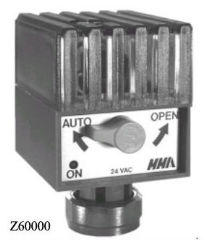 I have an older Actuator, the Macon Z60000. It has two settings, Auto and Open.
I have an older Actuator, the Macon Z60000. It has two settings, Auto and Open.
Right now it is on "open" and my forced hot water baseboards are usually fairly warm, not hot, but you can tell heat is coming from them and this happens even when its 85 degrees and the thermostat is off and when the batteries are removed and it has no power(not hardwired).
Should it be set to "auto", it would seem that is the case as no matter what I do I can't stop the heat. On 2022-08-15 by Jeremy Actuator, the
Reply by InspectApedia-911 (mod) - "OPEN" position forces the valve to remain open all the time
@Jeremy,
Here is the
MACON Z6000 ZONE VALVE INSTRUCTION SHEET [PDF]
If the valve is working properly it should be running in AUTO. The "OPEN" position forces the valve to remain open all the time - you may get heat when you don't want it - when there's no call for heat.
What happens is this: when the zone valve is forced "open" then hot water may circulate through the zone piping by normal convection (hot water rises, cool water falls in the piping loop) even when there is no call for heat and even when the circulator pump is not running.
Cause & cure for an overheated Taco zone control valve
I have an overheated Taco zone control valve, that is always hot, even when the boiler is off and water temp in it is down to 100 degrees with cold pipes.
When boiler is on, and pipes hot, the zone valve is very hot, and much hotter than the other taco valve on the system. -On 2022-04-27 by Liz O'Connor
Reply by Inspectapedia Com Moderator - overheated Taco zone control valve that is always hot
@Liz O'Connor,
"Always hot" circulator suggests a failed or failing motor or control.
But first check for a bad check valve on that zone loop: hot water could be circulating even when the zone motor is off.
IF the motor is hot and nearby pipes are cool then the motor itself is seized and perhaps electrically unsafe.
Where to find the wiring schematic for a Taco ZVC406 6 zone valve
Where can I find a schematic of the main board of a Taco ZVC406 6 zone valve control? - On 2022-03-10 by Anonymous
Reply by Inspectapedia Com Moderator - Taco wiring guide
@Anonymous,
Take a look at the wiring guides at
TACO ZONE CONTROLS WIRING GUIDE
Please let us know if you have additional questions.
What's the normal hot water pressure for a heating system>?
what is the hot water pressure for heating system normally? like 25psi? or something? i have no idea the close water pressure test for the zone valve by the manufacturer -On 2022-03-01 by Jason
Reply by Inspectapedia Com Moderator
@Jason,
The water pressure inside of a hydronic (hot water) heating boiler - a building heating system - is typically 12 psi cold and somewhere under 30 psi when the system is at its most-hot.
Zone valves have no trouble operating in that pressure range.
Cause of long delays in hot water heating out of the radiators
what can cause long delays in my hot water heating system actually having heat coming out of the registers? I got zone valves, Honeywell thermostats, Onrom relays, and a Taco pump Why is it taking so long as much as 30 minutes - On 2022-02-15 by Gene Lair
Reply by Inspectapedia Com Moderator -
@Gene Lair,
I'm unclear what kind of heat we are discussing.
I use the word "register" to refer to a warm air outlet - a furnace heating system - is your heat a water-to-air heating system?
Zone valves and Taco circulator pumps are, most-basically, associated with hot water heat delivered through radiators or baseboards or convectors.
So I'm guessing we have hot water heat and your radiators or baseboards are slow to warm up.
The cause of that delay could be a bad circulator pump (not running at all), a zone valve not opening, or air in the heating zone piping. You'll find articles on all of those in the article index.
Do noisy heating pipes mean a bad zone valve?
When pipes make noise, does that mean Zone valve bad? - On 2022-01-09 by Mary
Reply by Inspectapedia Com Moderator - Probably not. Different pipe noises mean different things
@Mary,
If the noise is gurgling water sounds there may be air in your heating water piping;
If the noise is buzzing or clicking from the zone valve motor, then the zone valve itself may be failing.
Since we have no idea what type of noise you're hearing, please first look at this article
PLUMBING NOISE DIAGNOSIS & CURE
which may help with your question. Also see
PLUMBING NOISE TYPE CHECKLIST
If those still leave you with questions, please let us know.
Do I have to cut the heating pipe to install a zone valve?
Does the pipe need to be cut to install a zone valve. - On 2021-11-22 by Carole
Reply by Inspectapedia Com Moderator - Yes. how to install a zone valve
@Carole,
Somewhere, logically, yes.
Consider that the zone valve is nothing more than a mechanical water flow valve on a loop of hot water heating pipe that
1. responds to a thermostat's call for heat
2. opens to allow hot water to flow through the zone
3. turns on the circulator pump once the valve is open
So I can't imagine any way to install a zone valve without installing it somewhere on the hot water heat piping loop for the zone it's intended to control. That means "interrupting" or cutting the pipe to place the valve in the path of water flow.
"Cut" pipe, I interpret conceptually, since physical "cutting" or sawing isn't necessarily required if instead there are threaded fittings that can be unscrewed.
How to replace Sparco PowerTrack zone actuators broken into pieces
Here is a pic of the system, any insight someone could provide on changing my zone valves and the steps I need to do to pull it off would be so appreciated!
I have 4, old, Sparco PowerTrack zone actuators on my system that are literally broken into pieces. I want to replace them with more modern zone valves (was thinking the Honeywell 3/4” Sweat valves).
I have no experience with boiler systems but no how to sweat and do copper plumbing. Can I just cut out the old actuators and install the new zone valves on my own?
I understand how to wire them.
I don’t know if I need to depressurize my system or drain it before I do any of that (or how to do those things, but would love to save my self hundreds to thousands of dollars from doing it myself)
On 2021-05-24 by Trevor -
Reply by (mod) replacement Sparco PowerTrack zone actuators from Honeywell.
@Trevor,
Forgive the slow reply - we've been swamped with questions.
plumbingsupply.com sells replacement Sparco PowerTrack zone actuators from Honeywell.
If the failure is the actual valve and not the motor then to repair these you'll need to
- cool down the heating system (turn it off and wait)
- drain off pressure and water from the lines enough that the piping in the area of work is empty (so it can be soldered) (open the boiler drain, using a hose to direct water to a safe drain location)
- disconnect and label the zone valve wiring connections - with POWER OFF
- cut out and sweat in new valves
- re-fill the heating system (assuming it's a water-only system)
- get the air out of the heating pipes so you won't be air-bound
(Search InspectApedia.com for AIR-BOUND HEATING SYSTEMS to see how we get the air out completely)
Keep me posted
How to two wire thermostat vs White Rogers 1311-102 Zone-A-Flow valves
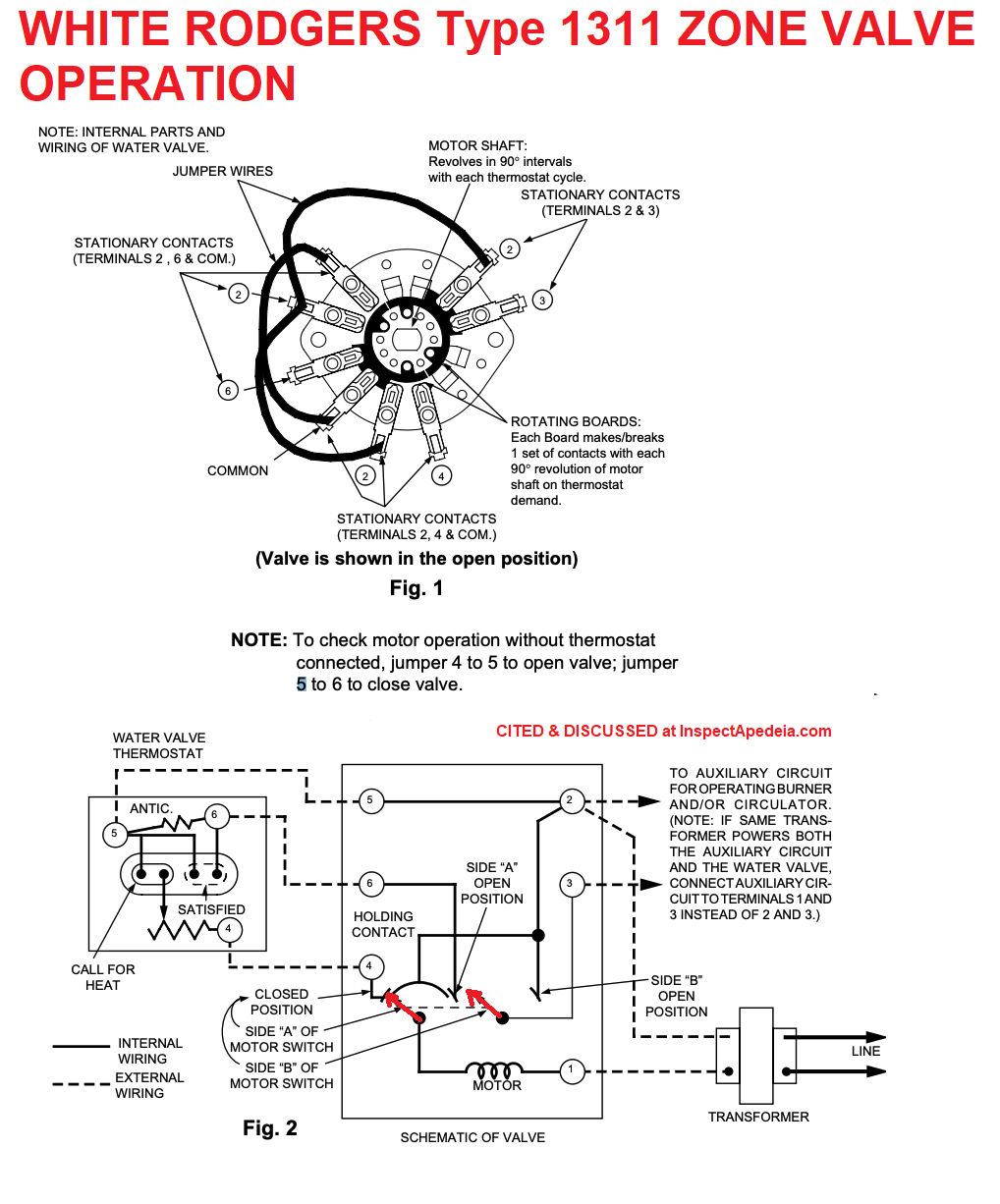 My boiler system has White Rogers 1311-102 Zone-A-Flow valves. These valves require thermostats to send current to the valve to turn it on, but then the valves require current to the opposite wires to turn the valve to the off position.
My boiler system has White Rogers 1311-102 Zone-A-Flow valves. These valves require thermostats to send current to the valve to turn it on, but then the valves require current to the opposite wires to turn the valve to the off position.
Just stopping current to the "ON" position will do nothing as the valve stays open.
Therefore a simple 2 wire thermostat will not work without a relay to send current to the off wires when the thermostat turns off, or a special thermostat that sends current one way when heat is on, and current through another wire to turn the valve off.
Why would anyone want a valve like that, instead of a spring or mechanism that just turns the valve automatically to the off position when the thermostat turns off? - On 2021-05-18 by Jon Green -
Reply by (mod) - White Rodgers Type 1311 Zone Valve Operation & Wiring
@Jon Green, Thanks for pointing out the operation of the WR-1311 Zone Valve
About the "why" of requiring electrical energy to close the valve when the thermostat is satisfied, I'm embarrassed to pretend to second guess WR's engineers who certainly know more about it than you or I, but maybe the idea was to make an inexpensive zone valve that would close more-reliably than a spring-operated valve.
Among zone valves are models that are
NO - Normally-Open, and use a current to close the valve
NC - Normally-closed, and use a signal to open the valve
and the
WR-1311 type zone valve that uses current both to open and to close the valve.
This excerpt describes the operation of the White Rodgers 1311
As the
thermostat calls for heat, the valve motor is energized and
begins to open the valve. Soon thereafter side “A” of motor
switch makes with the holding contacts.
This contact provides a
holding circuit to prevent the valve from stopping part way
through its cycle if the thermostat is changed to the satisfied
position.
Just before the valve reaches the full-open position,
side “B” of motor switch closes (providing a low voltage auxiliary
circuit for starting burner and/or circulator).
The motor stops with
the valve in the open position when side “A” of motor switch
breaks the holding contact.
(Completing a circuit through contact “6” and the thermostat anticipator.)
When thermostat is satisfied, the valve motor is again energized. Just after the valve starts to close, side “A” of motor switch
makes with holding contact providing a holding circuit.
The side
“B” of motor switch opens (breaking auxiliary circuit), and side
“A” of motor switch makes with contact “4” then breaks the
holding circuit stopping the valve in the closed position. (Fig. 2)
The contact arrangement is constructed so that when the shaft
of the motor revolves 90° a new set of stationary contacts makes
while the old set breaks. (Fig. 1)
For other readers, the installation instructions and wiring diagrams for this zone valve are at
WHITE RODGERS 1311 ZONE VALVE INSTRUCTIONS [PDF]
How to diagnose zone that sometimes does not open
I have 3 separate zone valves in my home. 1 value is for the basement apartment. At times it seems to be working normally; but at other times It will not call for heat until I turn the thermostat up for another zone valve. On 2021-05-13 by Anonymous
Reply by (mod) -
@Anonymous,
I would look first for a loose electrical connection and second I would consider replacing the zone valve actuator or motor that may be sticking or failing.
What is the point of this valve in the extension radiator loop
I have a boiler in an extension that provides hot water to the kitchen and extension.
The hot water and CH (central heating) in the original house are provided via a 22mm feed from the boiler via a Dunsley Nutraliser to the house radiators and bathroom hot water. All this works fine. All radiators have thermostatic valves to control the heat in individual rooms.
However, the 2 radiators in the extension are tapped off the 22mm feed to the main house and have a 2 port Honeywell Motorised Zone Valve in the loop (not in the 22mm).
This seems to have stopped working as the radiators were cold even with the Thermostatic Valves fully open.
Head has been removed and valve now moves very freely using very little finger force. Checking the wiring (5 wire) against a wiring diagram the orange wire goes to a connecting block but no further. This was a professional installation not DIY.
My understanding is that the orange is normally intended as a feed to tell the boiler to fire. However the boiler fires fine and must be getting signals fom other valves within the boiler itself.
What is the point of this valve in the extension radiator loop
as it just seems to get a signal to open from the controller, take a few seconds to open and then stay open until the programmer switches it off and the spring closes it?
Seems to be an unnecessary component in the system.
Thanks On 2021-02-19
by Dafydd
Reply by (mod)
I have made the mistake of removing and tossing a part whose function I couldn't understand.
Usually people don't go to the trouble of installing a valve or control unless it was needed.
But yeah, there can indeed be a "left-over" control from discontinued equipment or devices.
First let's get heat back: for those two zone valves: try putting the valve in the MANUAL OPEN position to see if that restores heat; that'll be diagnostic.
If the valve is open and you still have no heat in those zones and the circulator is - for sure - running, then in the ARTICLE INDEX see our advice on troubleshooting an AIRBOUND HEATING SYSTEM
Why add a zone valve? to have automatic control of heat in the location that the zone-valve-fed radiator(s) or base boards enjoy.
To change out a White Rogers Spin on or Twist On Zone Valve do you have to turn off the water
In order to change out a White Rogers Spin on or Twist On Zone Valve do you have to turn off the water or can you simply take off and twist on the new one? Thank you. On 2021-02-15 by John P
Reply by (mod) -
Typically the zone motor or actuator itself, (properly, the "zone motor assembly") including the White Rodgers models can be removed without interfering with piping
but if it's the valve itself I'd expect to turn off water and remove pressure from the zone.
Laars JVS boiler makes noise like an airplane
I have gas fired boiler laars mini therm jvs model and when one zone calls for hest boiler makes sound like plane passing by over the house but when two zones are calling for heat boiler runs fine snd the noise goes away. Do i have flow issue. Any advise is appreciated On 2021-02-10 by Ali
Reply by (mod) -
Ali
It's possible that there is air in the noisy zone, or that the zone valve actuator motor is buzzing and failing, or that a relay is buzzing;
More diagnostic suggestions are at HEATING SYSTEM NOISE DIAGNOSIS https://inspectapedia.com/heat/Heating_Noise_Diagnosis.php
One problem zone valve opens when I adjust the thermostat but the hot water only flows to the valve
I have a four zone one circulator pump hot water system. Three out of the four zones are working correctly.
The one problem zone valve opens when I adjust the thermostat but the hot water only flows to the valve and a little beyond then the line starts cooling down and I have no heat in that area. Could my circulator pump be bad although the other three zones are working? On 2020-12-15 by GEORGE DRAIN
Reply by (mod) -
If you're confident that the valve is opening then I suspect that zone is are bound. Use the on Page search box to look for our article series
on AIR-BOUND HEATING SYSTEMS to see how to diagnose and repair the problem.
Thermostat is turned down but heat keeps coming on
I have my thermostat turned down lowest it can go but the furnace keeps coming on, It heats hot water. The room temperature is 22 C and yet the thermostat is down all the way. Should I move the switch from auto to manual on the zone valve -On 2020-12-10 by miriam
Reply by (mod)
Miriam
Indeed when your boiler (hot water heating system or "hydronic heating boiler") is also used to make domestic hot water (for washing and bathing) the boiler will run form time to time to keep its temperature high enough to produce domestic hot water.
So that's normal.
But IF there is heat coming out of your radiators and baseboards long after the thermostat has stopped calling for heat, then see
HEAT WON'T TURN OFF
Boiler fires up even when there's no call for heat
The thermostat is at the lowest setting but our oil in floor heating system still fires up here and there (we don’t want the oil in floor on since we have electric heat pumps running). I noticed that the Manual Operating Levers on the actuators were in a half open position.
Is this what’s causing the system to fire up? Will putting the lever in a closed position cause any issues? -On 2020-11-05 by Nikki
Reply by (mod) -
Nikki
Is your boiler also making domestic hot water via tankless coil or an indirect water heater? If so that'd be a reason it still runs from time to time even if you're not calling for heat.
How do we know that a zone valve is working?
How do you check a zone valve to see if it is working? On 2020-11-04 by joseph simonelli
Reply by (mod) - turn up the thermostat and feel the pipes
Joseph
Thanks that's a very helpful question.
How do we know that a zone valve is working?
When the heat in the subject his own has been off for a while and the baseboards and radiators are cool turn the thermostat all the way up. Observe that the boiler runs and the circulator pump turns on.When the circulator pump is running you should be able to feel the heating pipe on the inlet and Outlet side of a zone valve go from being cool or cold to hot. If piping on the outlet side of the zone valve is hot then you can be pretty sure.
The heating boiler water is passing through the valve and the valve is open.
Noisy zone valve won't open
Have a boiler with three zones, two for upstairs, one downstairs. The zone valve (Honeywell) which feeds the upstairs kitchen/dining/living/bath (large area) is making noise, overheating, and not opening when the thermostat calls for it to. I have to sometimes push the lever to the right to lock it in the open position.
I don't like leaving it like that, so I put it there at night when the house gets cold, put it back to normal during the day.
I'm sure it needs to be replaced. Is this a pretty easy fix for the homeowner?
I'm have 30 years of maintenance experience changing pumps, motors, valves, piping systems, etc., though it is mostly heavy indusrial.
I just look at this as a scaled down version of what I do for work. Can't the module be changed out separately instead of changing the valve? Also, can the zones valves be installed on the return side of the boiler instead of the supply side? They seem to always be very warm/hot. On 2020-09-29 by Steven
Reply by (mod) - "sticking" zone valve repair
Steven:
Thanks for a helpful "sticking" zone valve repair question.
There are two different situation:
If the zone valve failure is in the actuator motor, that's a pretty easy repair as the cover can be removed, the motor removed, and a replacement installed without having to do any plumbing work.
The motor sits atop and operates a mechanical shaft that, by rotating, opens and closes the zone valve in response to a call for heat from the thermostat. Many homeowners can do such a repair.
But if the zone valve problem is not the motor but the actual valve in the valve body - the parts that rotate to either allow or not allow hot heating water to flow through the piping, then what's needed is to cut-out or de-solder the old valve and put in a new one; that in turn also will require cooling down the heating system and draining the zone, the re-filling the zone after the repair, and then purging air from the system after that.For that work, the job probably goes faster and easier when done by a trained heating service tech or plumber who is familiar with zone valve replacement.
Which zone valve brand is best?
replacing boiler zone valves (have boiler serving 8 condominium units), which is better: taco zone actuator or Honeywell mechanical valve? On 2020-09-21 by Anonymous-
Reply by (mod) -
Anon:
Heating System Zone Valve Failure Rates, Failure Data, Honeywell vs Taco
Thank you for a helpful question on the reliability or quality of Taco vs Honeywell zone valves and actuators.
I have used, installed, and repaired both brands of zone valves since the 1970s; In the northeastern U.S. I've seen more Honeywell than Taco zone valves installed, but I have no actual zone valve failure rate data that demonstrates one BRAND is "better" than the other.
Reading comments by various HVAC service techs we see an OPINION that "which is better" Honeywell or Taco turns in part on which zone valve model you're installing. I've seen some complaints about the TACO No. 271 and other complaints about the TACO 500 series and I've seen kudos and praise of the TACO ZVC series zone valves.
"Complaints" are anecdotal reports, not peer-reviewed expert research on failure rates. It's likely that both Taco and Honeywell have failure data for their products based on their own research, on field reports, or both. But I've not found that data available to the public.
Bottom line: Both Honeywell and Taco make reliable zone valves.
But Watch out: wiring a MIX of the two brands on a single heating system requires some care as the two brands are not wired identically. We discuss that in this article series.
Humming noise at zone valve: is this trouble?
I live in a condo and the zone valve was hot to the touch and made a humming sound - is this a problem? -
I turned my thermostat right off and the valve cooled slightly to warm to touch but still makes humming sound -
thermostat is presently off and it is possible the building heat has just been turned on for fall -
I have no need for heat at the moment just possibly overnight - I am on the third floor -
should I consider replacing the valve or turning on the heat to clear the system and then turn it down? On 2020-09-15 by wendy
Reply by (mod) -
Wendy
It's common for the body of the zone valve to be hot as it's passing hot water for the heating system.But a humming sound may mean that the valve's motor is jamming (needs replacement) OR that a nearby low voltage transformer is humming and will need replacement soon. See if you can pin down the noise source precisely.
Followup by wendy
if I gently push on the valve the humming changes
Turned up thermostat - got heat and no more noise. so all good. thx
Reply by (mod) -
Good news about the heat, Wendy;
...
Continue reading at ZONE VALVE MANUALS & WIRING INDEX or select a topic from the closely-related articles below, or see the complete ARTICLE INDEX.
Or see ZONE VALVE DIAGNOSTIC FAQs for help with diagnosing zone valve problems
Or see these
Recommended Articles
- AIRBOUND HEAT SYSTEM REPAIR by WATER FEED VALVE if your heating zones don't get hot even though the zone valve opens, the circulator runs, and the boiler heats.
- CIRCULATOR PUMPS & RELAYS
- DIAGNOSE & FIX HEATING PROBLEMS-BOILER - home
- DISSOLVED OXYGEN DAMAGE CONTROL
- MANUALS for HEATING & A/C SYSTEM CONTROLS
- RADIATOR & ZONE CONTROL MANUALS
- THERMOSTATS, HEATING / COOLING
- ZONE CONTROLLER TACO ZVC403
- ZONE VALVES, HEATING - home
- ZONE VALVE BANGING or BACKWARDS
- ZONE VALVE MANUALS & WIRING INDEX
- ZONE VALVE SIZE vs GPM
Suggested citation for this web page
ZONE VALVES, HEATING at InspectApedia.com - online encyclopedia of building & environmental inspection, testing, diagnosis, repair, & problem prevention advice.
Or see this
INDEX to RELATED ARTICLES: ARTICLE INDEX to HEATING SYSTEMS
Or use the SEARCH BOX found below to Ask a Question or Search InspectApedia
Ask a Question or Search InspectApedia
Try the search box just below, or if you prefer, post a question or comment in the Comments box below and we will respond promptly.
Search the InspectApedia website
Note: appearance of your Comment below may be delayed: if your comment contains an image, photograph, web link, or text that looks to the software as if it might be a web link, your posting will appear after it has been approved by a moderator. Apologies for the delay.
Only one image can be added per comment but you can post as many comments, and therefore images, as you like.
You will not receive a notification when a response to your question has been posted.
Please bookmark this page to make it easy for you to check back for our response.
IF above you see "Comment Form is loading comments..." then COMMENT BOX - countable.ca / bawkbox.com IS NOT WORKING.
In any case you are welcome to send an email directly to us at InspectApedia.com at editor@inspectApedia.com
We'll reply to you directly. Please help us help you by noting, in your email, the URL of the InspectApedia page where you wanted to comment.
Citations & References
In addition to any citations in the article above, a full list is available on request.
- Honeywell V8043D zone valve [PDF installation instructions], Honeywell Corporation, 2985 Douglas Drive North, Golden Valley MN 55433, retrieved 2/3/14 original source: https://customer.honeywell.com/resources/techlit/ TechLitDocuments/95c-00000s/95C-10938B.pdf
- Our recommended books about building & mechanical systems design, inspection, problem diagnosis, and repair, and about indoor environment and IAQ testing, diagnosis, and cleanup are at the InspectAPedia Bookstore. Also see our Book Reviews - InspectAPedia.
- Fuel Oil & Oil Heating Magazine, 3621 Hill Rd., Parsippany, NJ 07054, 973-331-9545
- In addition to citations & references found in this article, see the research citations given at the end of the related articles found at our suggested
CONTINUE READING or RECOMMENDED ARTICLES.
- Carson, Dunlop & Associates Ltd., 120 Carlton Street Suite 407, Toronto ON M5A 4K2. Tel: (416) 964-9415 1-800-268-7070 Email: info@carsondunlop.com. Alan Carson is a past president of ASHI, the American Society of Home Inspectors.
Thanks to Alan Carson and Bob Dunlop, for permission for InspectAPedia to use text excerpts from The HOME REFERENCE BOOK - the Encyclopedia of Homes and to use illustrations from The ILLUSTRATED HOME .
Carson Dunlop Associates provides extensive home inspection education and report writing material. In gratitude we provide links to tsome Carson Dunlop Associates products and services.


